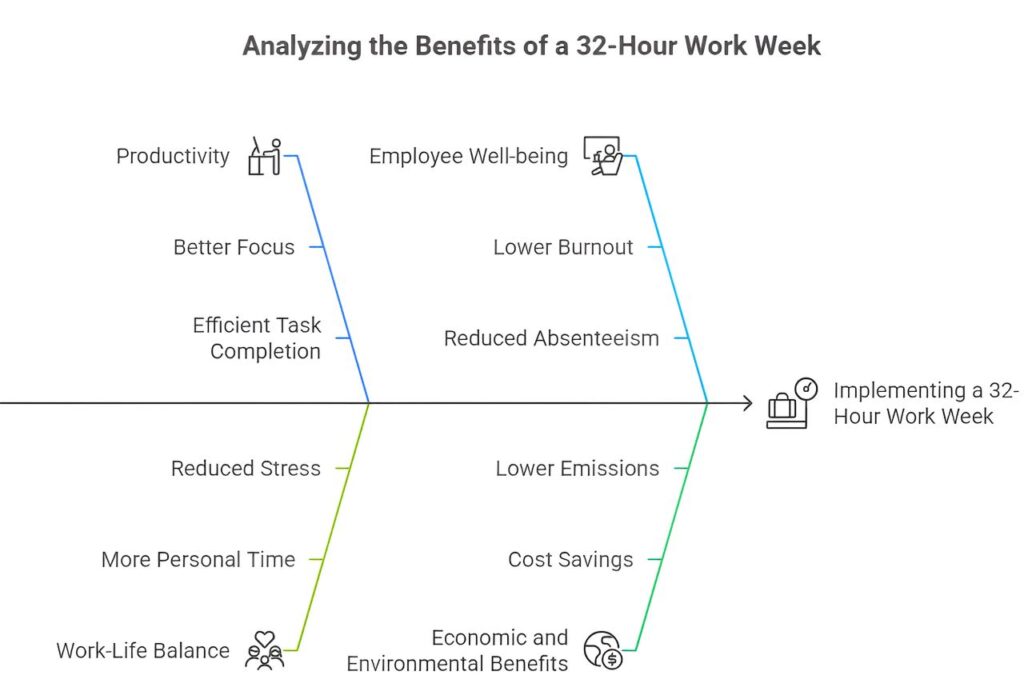The 32 hour work week is gaining momentum as a topic of serious discussion in the workplace and beyond. With employees and employers alike rethinking traditional work structures. The idea of a shorter workweek is sparking debates on productivity, mental health, and the future of labor. Advocates argue that reducing work hours without compromising pay could improve work-life balance and overall efficiency, while skeptics question its practicality and economic impact.
I. The 32 Hour Work Week Explained
1. What is the 32 Hour Work Week?
The 32 hour work week represents a shift from the traditional 40-hour workweek, reducing the number of hours employees are expected to work while maintaining their full-time status and pay. Typically structured as four 8-hour days, it emphasizes efficiency over time spent at the workplace. However, some companies also explore flexible arrangements, allowing employees to distribute 32 hours across more than four days based on personal preferences and job requirements.
2. How It Differs from Other Reduced-Hour Models
The 32 hour work week is distinct from other models, such as part-time schedules or compressed workweeks.
- Part-Time vs. 32 Hour Week: Unlike part-time roles, which often come with reduced pay and benefits, the 32 hour model ensures full compensation and benefits.
- Compressed Workweek vs. 32 Hour Week: In a compressed workweek, employees work 40 hours over fewer days (e.g., four 10-hour days). The 32 hour work week, on the other hand, reduces the overall workload, focusing on output rather than time logged.
3. Why is the 32 Hour Work Week Gaining Attention?
Several factors contribute to the growing interest in this model:
- Technological Advancements: Automation and digital tools have significantly increased productivity, reducing the need for long work hours.
- Employee Well-Being: Burnout and mental health challenges have prompted businesses to reconsider traditional work structures.
- Global Competitiveness: Countries and companies adopting shorter workweeks are reporting higher employee satisfaction, lower turnover rates, and even economic growth.
4. Industries and Roles Most Suited to the 32 Hour Work Week
While the model shows promise, its feasibility depends on the nature of the job and industry:
- Flexible and Creative Roles: Jobs in marketing, IT, design, and other creative sectors have shown greater adaptability to shorter workweeks.
- Customer-Focused Services: Companies with call centers or customer support roles are implementing rotational staffing to maintain 24/7 availability while offering employees shorter shifts.
- Challenging Sectors: Industries requiring round-the-clock staffing, such as healthcare and manufacturing, face greater logistical and financial challenges.
5. Insights from Real-World Experiments
Countries and businesses have tested the 32 hour work week with varying levels of success:
- Iceland: Between 2015 and 2019, Iceland conducted one of the largest trials, involving thousands of workers across public and private sectors. Reports revealed that productivity remained stable or improved, and workers reported increased well-being.
- United Kingdom: Pilot programs in the UK involving over 60 companies showed similar results, with many firms deciding to permanently adopt the model.
- United States: Companies like Kickstarter and Microsoft have experimented with four-day workweeks, reporting higher job satisfaction and improved output.

Also Read: How To Stop Giving 40 Hours Of Your Life Every Week
II. Advocates and Legislative Efforts
1. Political Figures Driving the Movement
Key politicians and leaders around the world are advocating for the 32 hour work week:
- United States: Representative Mark Takano and Senator Bernie Sanders proposed legislation to amend the Fair Labor Standards Act, reducing the standard workweek to 32 hours. This proposal reflects growing recognition of changing work dynamics in the digital age.
- European Leaders: Governments in countries like Spain and Belgium are incentivizing businesses to explore reduced-hour workweeks through grants and support programs.
2. Organizations Promoting Change
Several advocacy groups are championing the adoption of shorter workweeks:
- 4 Day Week Global: This organization partners with companies and researchers to test and implement reduced-hour workweeks. Their data-driven approach highlights the benefits for employees and businesses alike.
- Trade Unions: Labor organizations in multiple countries are pushing for legislative reforms to address overwork and improve work-life balance.
3. Legislative Proposals in Detail
Efforts to legislate the 32 hour work week aim to create a balanced and sustainable transition:
- Worker Protections: Proposed bills ensure no reduction in pay or benefits for employees moving to shorter hours.
- Incentives for Employers: Governments are offering tax breaks, subsidies, and pilot program funding to encourage businesses to adopt the model.
- Phased Implementation: Some proposals advocate for gradual transitions, allowing businesses to adjust processes and evaluate outcomes.
4. Countries Leading the Way
- Spain: In 2021, the Spanish government allocated €50 million to fund trials for companies exploring shorter workweeks. In 2023, the Spanish government launched the three-year, €50 million trial to incentivize small and medium-sized companies to adopt a four-day, 32-hour week without cutting pay. Early results indicate positive impacts on productivity and employee well-being.
- Japan: Known for its work culture challenges, Japan is experimenting with policies encouraging companies to adopt shorter work schedules. The goal is to reduce burnout and increase workforce participation.
- New Zealand: Companies like Perpetual Guardian have embraced a four-day workweek, reporting significant improvements in employee engagement and stress reduction.
5. Barriers to Legislative Success
Despite growing support, implementing shorter workweeks faces resistance:
- Business Concerns: Employers worry about potential revenue losses, staffing shortages, and the cost of hiring additional workers to fill gaps.
- Sector-Specific Challenges: Certain industries, particularly those requiring constant coverage, may find the transition complex and costly.
- Cultural Resistance: In countries with a deeply ingrained work ethic, shorter workweeks may face skepticism regarding productivity and professionalism.
III. Benefits of a 32 Hour Work Week
1. Enhanced Productivity
Numerous studies indicate that reducing work hours can boost productivity. Employees tend to focus better and complete tasks more efficiently when their work time is limited, eliminating unnecessary distractions and time wastage.
2. Improved Work-Life Balance
A 32 hour work week allows employees to allocate more time to personal responsibilities, hobbies, and family. This balance contributes to overall happiness and reduces stress levels, promoting better mental health.
3. Reduction in Burnout and Absenteeism
Shorter workweeks have been linked to lower rates of burnout. Employees with adequate time to recharge are less likely to experience exhaustion, leading to reduced absenteeism and a healthier workforce.
4. Increased Employee Retention
Companies that adopt flexible and reduced-hour work schedules often experience higher employee satisfaction, translating into lower turnover rates. Workers are more likely to remain loyal to organizations that prioritize their well-being.
5. Attracting Top Talent
Businesses offering a 32 hour work week gain a competitive edge in recruitment. In a competitive job market, flexible and innovative work arrangements appeal to skilled professionals seeking balance and progressive workplace policies.
6. Economic Benefits for Employers
While the model reduces hours, businesses have reported cost savings in other areas, such as reduced utility usage and lower employee healthcare expenses. Enhanced productivity often offsets concerns about financial drawbacks.
7. Environmental Advantages
A shorter workweek can decrease commuting, leading to lower greenhouse gas emissions. Reduced office operations also contribute to a smaller environmental footprint, aligning with sustainability goals.

Also Read: 15 Best Low-Stress Jobs That Pay Well (With Salaries)
IV. Challenges and Considerations
1. Potential Impact on Pay Structures
For businesses, one concern is how to maintain salaries while reducing hours. Companies may face financial strain if productivity gains do not fully offset the cost of unchanged compensation levels.
2. Difficulties in Coverage for Certain Roles
Industries requiring continuous operations, such as healthcare, hospitality, and logistics, may struggle to adopt the 32-hour model. Filling gaps without compromising service quality presents a logistical challenge.
3. Adaptation Period for Businesses
Transitioning to a shorter workweek involves adjustments to processes, workflows, and expectations. Companies need time and resources to implement changes, making the adoption process potentially burdensome.
4. Equity Among Employees
Organizations must ensure fairness in workload distribution. Some employees may feel overburdened if responsibilities are not evenly shared, which could negatively impact morale.
5. Uncertainty in Measuring Long-Term Benefits
Although pilot programs show promising results, scaling the 32-hour work week across diverse industries and geographies involves uncertainties. Long-term studies are needed to evaluate its broader economic and social impacts.
6. Resistance from Traditional Mindsets
Some organizations and leaders adhere to traditional work paradigms that value long hours as a measure of commitment. Overcoming these ingrained beliefs requires cultural shifts and education.
7. Balancing Client or Customer Expectations
Businesses in service-oriented industries may face challenges in meeting client demands with fewer working hours. Maintaining customer satisfaction while adapting to a new schedule requires strategic planning.
V. Future Outlook
The 32 hour work week is more than a workplace trend, it represents a shift in how societies value time, productivity, and well-being. As industries evolve, and technological advancements reduce the need for traditional labor-intensive practices, the idea of shorter workweeks becomes increasingly practical. This change signals a move toward aligning economic goals with the personal needs of workers.
Looking ahead, businesses that embrace innovative work models are likely to gain a competitive edge. The younger workforce, prioritizing flexibility and balance, is driving demand for progressive workplace policies. At the same time, the global economy is observing the potential for these models to improve efficiency, reduce burnout, and support sustainability initiatives.
The widespread adoption of the 32 hour work week hinges on collaboration between policymakers, businesses, and workers. By addressing challenges and building on successful pilot programs, this vision could reshape work dynamics worldwide, setting a foundation for healthier, more productive, and more inclusive workplaces.



